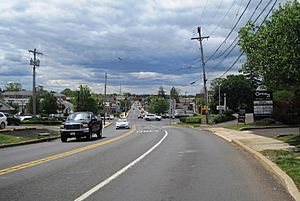Southampton, Pennsylvania facts for kids
Quick facts for kids
Southampton
|
|
|---|---|

Approaching PA 132 from PA 232 southbound
|
|
| Country | United States |
| State | Pennsylvania |
| County | Bucks |
| Township | Upper Southampton |
| Elevation | 256 ft (78 m) |
| Time zone | UTC-5 (EST) |
| • Summer (DST) | UTC-4 (EDT) |
| ZIP code |
18966
|
| Area code(s) | 215, 267 and 445 |
Southampton is a small community in Upper Southampton Township, Bucks County, Pennsylvania. It's a place where people live and work, but it's not an official city or town with its own government.
Where is Southampton Located?
Southampton is about 18 miles north of the center of Philadelphia. Its main ZIP Code is 18966. Some parts of this ZIP Code are also known as Churchville or Holland.
Geographic Borders and Neighboring Areas
This community is in the western-central part of Bucks County, Pennsylvania. It borders Montgomery County to the west. Southampton is found within two townships: Upper Southampton and Northampton.
Schools Serving Southampton Students
Students in Upper Southampton Township attend schools in the Centennial School District. They go to William Tennent High School, which is in nearby Warminster.
Students in Northampton Township are part of the Council Rock School District. Most attend Council Rock High School South, which is located in the Southampton area (but addressed as Holland). Some students go to Council Rock High School North in Newtown Township.
Many students from both districts can also attend Middle Bucks Institute of Technology. This is a special vocational school in Jamison where they can learn job skills.
The Rich History of Southampton
Southampton, Pennsylvania, got its name from Southampton, England. This was the port where followers of William Penn sailed from to reach the new land of Pennsylvania.
Early Days and Land Ownership
By 1685, Southampton was officially recognized as a township. The land was given to thirteen original buyers. Their properties were shown on an early map of Pennsylvania.
The original boundaries of Southampton stretched east to Bensalem. It wasn't until 1929 that the township was split into "Upper Southampton" and "Lower Southampton." Today, its neighbors include Feasterville, Huntingdon Valley, Warminster, and Churchville.
Peaceful Land Purchase
To live peacefully with the Native Americans, William Penn bought the land from the Lenni-Lenape Chief Tamanend. He paid with wampum and other useful items like tools and clothing. This purchase happened on June 23, 1683.
Early Settlers and Churches
Many of the first English settlers were Quakers. They came to Pennsylvania to escape religious persecution. A group of Quakers and members of the Pennepek Baptist Church formed the Southampton Baptist Church in 1746.
Dutch colonists also arrived in Southampton in the 1700s. They moved south from Long Island, New York. They settled in an area called Smoketown, which later became Churchville. This name came from the North and Southampton Reformed Church built there. The churchyards of both the Baptist and Reformed churches hold graves of patriots from the Revolutionary War.
Farming and Transportation Development
For many years, farming was the main way of life in Southampton. Roads were built to connect farms to mills, markets, and churches. Second Street Pike was a key road. Farmers used it to take their crops by horse and wagon to markets in Philadelphia.
In the mid-1800s, small villages like Davisville, Churchville, and Southamptonville (also called "Fetter's Corner") grew at important crossroads. Second Street Pike even became a toll road, where people paid to use it.
Innovation and the Railroad
In 1785, the inventor John Fitch lived nearby. He tested a small model of a steamboat in a stream on a friend's property. This spot is now in Upper Southampton Township. The steamboat is even shown on Upper Southampton Township's official seal!
The railroad arrived in the 1870s, bringing big changes. "Southamptonville" became simply Southampton. Farmers could now send their milk and produce to market much faster. Tradespeople opened shops, and residents began traveling to Philadelphia for work.
Modern Changes and Education
Changes continued into the 1900s. Electricity and telephone lines were installed. Street Road was widened in 1969-1970, and a railroad overpass was built. This required removing some old buildings.
Public education started in the mid-1800s. One-room schoolhouses once stood at Street Road and Gravel Hill, and on County Line Road. The old Southamptonville schoolhouse was expanded and is now First Children Academy. The original "Southampton High School" became Shelmire Elementary School. A new high school, William Tennent High School, was built in 1953.
The first public school in Davisville, called the Davisville Seminary, is still there today. It's on Street Road, next to the Dairy Queen.
Upper Southampton Township has grown with new businesses and buildings. But it still feels like a small town, even with all the changes over the years.


